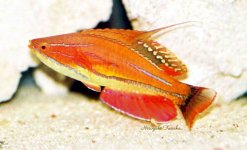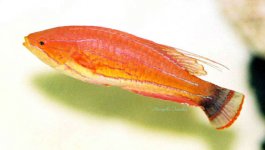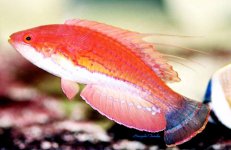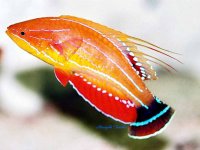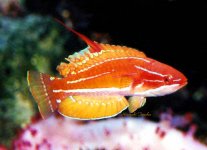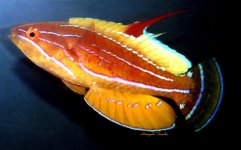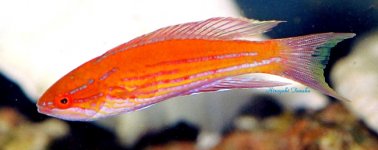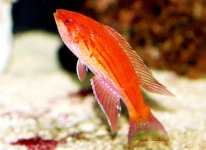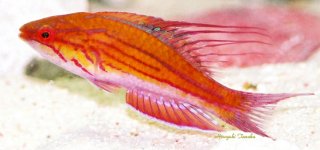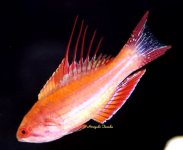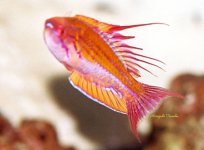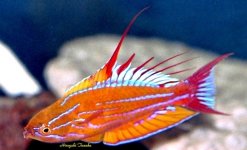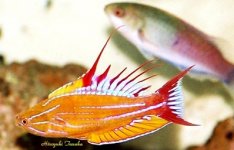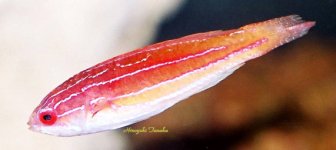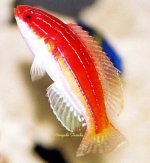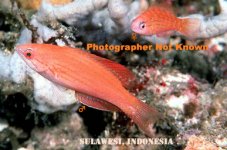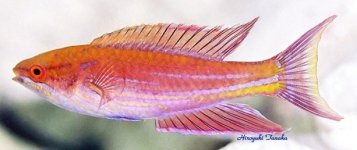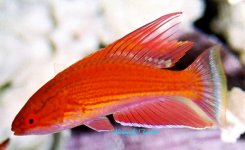You are using an out of date browser. It may not display this or other websites correctly.
You should upgrade or use an alternative browser.
You should upgrade or use an alternative browser.
Flasher Wrasses
- Thread starter Hiroyuki Tanaka
- Start date
This is a male of Carpenter's Flasher Wrasse, male, 8.5cm, from the Philippines.
It ranges the Philippines, northern Indonesia, Palau, southern Japan (the Izu Islands to Okinwa region), Papua New Guinea to the Solomon Islands. It is replaced in the Indian Ocean by P. mccoskeri.
It is greatly similar to P. mccoskeri from the Indian Ocean, but P. carpenteri has two to four filaments on dorsal fin (single in mccoskeri). Also P. carpenteri possesses some blackish area on caudal and dorsal fins.
When it folds all fins it cannot be distinct from P. mccoskeri, as seen in such the photo.
It ranges the Philippines, northern Indonesia, Palau, southern Japan (the Izu Islands to Okinwa region), Papua New Guinea to the Solomon Islands. It is replaced in the Indian Ocean by P. mccoskeri.
It is greatly similar to P. mccoskeri from the Indian Ocean, but P. carpenteri has two to four filaments on dorsal fin (single in mccoskeri). Also P. carpenteri possesses some blackish area on caudal and dorsal fins.
When it folds all fins it cannot be distinct from P. mccoskeri, as seen in such the photo.
Attachments
This specimen is now spreading all fins and differences between this species and P. mccoskeri can be seen.
It has four filaments on dorsal fin, however most specimens available at retailers have two to three there.
Note the red area on anal fin; it is almost identical in appearance to that of P. mccoskeri.
It has four filaments on dorsal fin, however most specimens available at retailers have two to three there.
Note the red area on anal fin; it is almost identical in appearance to that of P. mccoskeri.
Attachments
It is a coloration of displaying. The red on anal fin became intense, lines turned blue, and the body changed to bright yellow. It often exibits such colors in seconds but it does not last so long, some 10 seconds.
This specimen is the same male with that shown above.
This specimen is the same male with that shown above.
Attachments
This is very similar to P. carpenteri and P. mccoskeri.
The species has a single to four filaments on dorsal fin, but also possesses a yellow anal fin, therefore it was named Yellowfin FW.
It ranges Indonesia (Bali, Sulawesi to Flores) and off the coast of Western Australia. In Australia and Flores the males have a single filament, however most specimens available at shops have two to three filaments. It will be often shipped from Bali and one the cheapest species among the genus.
The species has a single to four filaments on dorsal fin, but also possesses a yellow anal fin, therefore it was named Yellowfin FW.
It ranges Indonesia (Bali, Sulawesi to Flores) and off the coast of Western Australia. In Australia and Flores the males have a single filament, however most specimens available at shops have two to three filaments. It will be often shipped from Bali and one the cheapest species among the genus.
Attachments
This is male of Yellowfin FW in display. A shorter, the second filament on the dorsal fin can be seen.
The species is distinct also in having red filament(s), while in males of the relatives P. mccoskeri & P. carpenteri the filament(s) are yellow.
Also compare it with P. rubricaudalis (shown above).
The species is distinct also in having red filament(s), while in males of the relatives P. mccoskeri & P. carpenteri the filament(s) are yellow.
Also compare it with P. rubricaudalis (shown above).
Attachments
It is P. angulatus, 65mm, from Indonesia. It comes also from the Philippines but does not have a wide range and availability is not so great.
This species has a deep lunate tail, triangular dorsal and anal fins and have no filament on dorsal fin.
This species has a deep lunate tail, triangular dorsal and anal fins and have no filament on dorsal fin.
Attachments
Len, thanks for the reply.
>I think I need to set up a small tank for a harem of flasher wrasses So you previously mentioned you can keep multiple species in one tank.
It is good to have a Flasher Wrasse room.
>Does this include multiple harems?
It seems difficult to maintain harems of a species, for I think that each harem will be separetd to individuals finally.
>I think I need to set up a small tank for a harem of flasher wrasses So you previously mentioned you can keep multiple species in one tank.
It is good to have a Flasher Wrasse room.
>Does this include multiple harems?
It seems difficult to maintain harems of a species, for I think that each harem will be separetd to individuals finally.
Getting a pair would be ideal but it is difficult to obtain a perfect pair at retailers. It is possible that you get pairs (males and females) of the same species in a tank, and then you may have more chance to see their displays.
I always keep many males of different species, often together with some males of Cirrhilabrus, only to enjoy their colors, and no need to get female. They will display well in the evening to night. Put off all the room-lights as you know.
I always keep many males of different species, often together with some males of Cirrhilabrus, only to enjoy their colors, and no need to get female. They will display well in the evening to night. Put off all the room-lights as you know.
This is one of the most populra species in the wild and shops, Paracheilinus filamentosus.
It was described by the leading ichthyologist Gerry Allen, based upon specimens from Papua New Guinea and the Solomon Islands (Melanenia). It has six to eight filaments on dorsal fin and a deeply lunate tail but no dark dots between the lines on side. Greatly similar to P. cyaneus but this species possesses dark dots on upper side.
It was described by the leading ichthyologist Gerry Allen, based upon specimens from Papua New Guinea and the Solomon Islands (Melanenia). It has six to eight filaments on dorsal fin and a deeply lunate tail but no dark dots between the lines on side. Greatly similar to P. cyaneus but this species possesses dark dots on upper side.
Attachments
The same fish displays; the dorsal fin turns whitish blue, and the lines on side became blue. Also the posterior part of tail flashes as neon.
The second and third filaments are missing, probably due to the result of some fighting.
The second and third filaments are missing, probably due to the result of some fighting.
Attachments
This is the last member that I have experienced in my home.
It was named with its attenuate tail, but as this specimen is still young it the caudal fin is not long. The tail will become like a shape of diamond when it becomes an adult.
The young male is 65mm long, and a single filament on the center of dorsal fin will become long as growth.
This one came from Kenya and it mainly ranges the Seychelles.
It was named with its attenuate tail, but as this specimen is still young it the caudal fin is not long. The tail will become like a shape of diamond when it becomes an adult.
The young male is 65mm long, and a single filament on the center of dorsal fin will become long as growth.
This one came from Kenya and it mainly ranges the Seychelles.
Attachments
The same specimen, 65 mm long, shipped from Kenya.
You can see the short filament on dorsal fin, that would get longer. The filament is narrower than that of P. mccoskeri. Also the tail will become more rhomboid, but in P. mccoskeri it is rounded.
The species is available on rare occasion, approximately only one individual per year in Japanese market.
You can see the short filament on dorsal fin, that would get longer. The filament is narrower than that of P. mccoskeri. Also the tail will become more rhomboid, but in P. mccoskeri it is rounded.
The species is available on rare occasion, approximately only one individual per year in Japanese market.
Attachments
This is an underwater photograph of an ultra rare species, Paracheilinus togenanesis, Togean FW.
The pic shows a pair of male and female (in the background), and was photographed at Sulawesi. Photographer's name is not known, and I found it in the US Fish Base some three years ago. It was erroneously shown as P. angulatus and I asked the editor to correct its name, but the photo was deleted since then. Some webs still show it as P. angulatus.
The species is restricted to Togean Island, northeastern Sulawesi, Indonesia and only merely a few photos are known to date.
The shape of dorsal fin in males is quite distinctive and there is no filament, and it has a deeply lunate tail. P. angulatus has pointed dorsal and anal fins.
I have never seen it in any market, and even famous divers who dive frequently in Indonesia could not have obsereved it.
The pic shows a pair of male and female (in the background), and was photographed at Sulawesi. Photographer's name is not known, and I found it in the US Fish Base some three years ago. It was erroneously shown as P. angulatus and I asked the editor to correct its name, but the photo was deleted since then. Some webs still show it as P. angulatus.
The species is restricted to Togean Island, northeastern Sulawesi, Indonesia and only merely a few photos are known to date.
The shape of dorsal fin in males is quite distinctive and there is no filament, and it has a deeply lunate tail. P. angulatus has pointed dorsal and anal fins.
I have never seen it in any market, and even famous divers who dive frequently in Indonesia could not have obsereved it.
Attachments
This a hybridized specimen of Paracheilinus, a male 65 mm from northern Indonesian waters.
The shape of fins is similar to that of P. angulatus but has several filaments on dorsal fin. It is most possible that a hybrid cross between P. angulatus and P. lineopunctatus.
Both species overlap in range; Philippines and northern Indonesia. See following photos of the same specimen.
The shape of fins is similar to that of P. angulatus but has several filaments on dorsal fin. It is most possible that a hybrid cross between P. angulatus and P. lineopunctatus.
Both species overlap in range; Philippines and northern Indonesia. See following photos of the same specimen.




